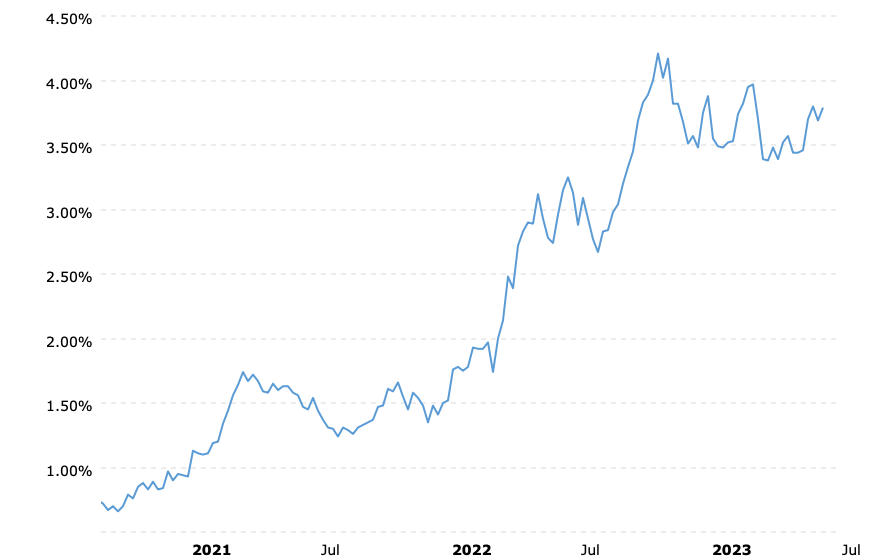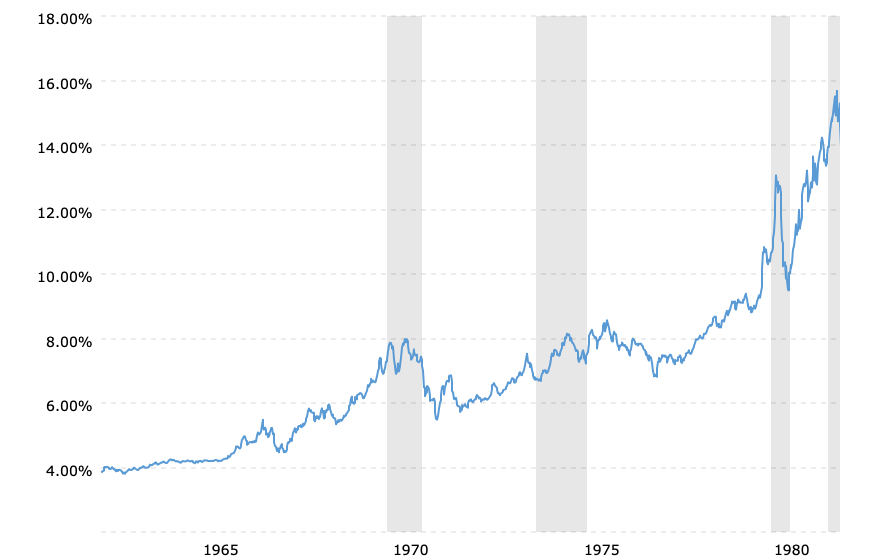For most investors and market analysts today, there is little or no reference to the period 1960-80 as it pertains to gold and interest rates. There are some of us around, though, who experienced it both personally and professionally.
The Fed’s concerted effort to raise rates has been underway for a little over one year now, and investors are starting to wince. But, the increase in interest rates from all-time lows at near-zero level started almost three years ago in August 2020. See the chart below…
10 Year Treasury Rate Since August 2020
During the time period pictured above, the 10 Year Treasury rate has increased from .55% to as high as 4.2% last fall.
That is a huge increase and has had substantial impact on the financial markets and the economy. But it might not seem quite so bad after viewing the next chart just below…
10 Year Treasury Rate 1962-1981
For nearly twenty years between March 1962 and September 1981, the 10 Year Treasury rate increased from 3.86% to 15.68%.
Interest rates currently are at the same approximate level as in 1962. How much impact on the markets and the economy do you think we would see if interest rates continued their march upwards over the next seventeen years (2040) to in excess of 15%?
GOLD
Interest rates had more than doubled by the time President Nixon severed all convertibility between gold and the U.S. dollar in 1971. From that point forward interest rates doubled again, reaching the peak of more than 15% that was mentioned earlier.
Meanwhile the price of gold rose from $35 oz. to $850 oz., its intraday high January 1980.
GOLD AND INTEREST RATES
There is no correlation between gold and interest rates. Whereas, gold and interest rates rose simultaneously all during the 1970s, they moved in opposite directions during 2001-2011.
During 2001-2011, the gold price increased from $250 oz. to $1895 oz. while interest rates continued their multi-decade decline towards historic lows near zero three years ago.
GOLD AND THE U.S. DOLLAR
The price of gold rises over time to reflect the loss in purchasing power of the U.S. dollar that has previously occurred.
The higher price for gold relative to that loss in purchasing power of the U.S. dollar maintains the purchasing power of gold.
Hence, an ounce of gold today is no more valuable than it was a century ago. A higher price for gold tells us nothing about gold. It tells us how much purchasing power the U.S. dollar has lost.
Gold’s value is in its use as money. Gold is a long-term store of value.
WHAT’S NEXT FOR INTEREST RATES, GOLD AND THE DOLLAR?
Where interest rates go from here is not solely up to the Federal Reserve. Interest rates were forced to unreasonably low historic levels by errant Fed policy for three decades.
They could rise considerably higher or reverse lower depending on bond investors interpretation of inflation risk.
If bond investors feel inflation is a bigger risk, then interest rates could go much higher, especially for longer-term bonds.
At some point, bond investors might buy existing bonds more aggressively to lock in current relatively higher rates. At the least, this would stabilize rates and possibly bring them down.
Action, or inaction, by the Fed could exacerbate or alter any of the above market scenarios.
A higher gold price would eventually happen after further loss in U.S. dollar purchasing power over a period of time.
Gold could decline in price, too; depending on a lessening of inflation effects and strength in the U.S. dollar.
All in all, the next few months should be historic in nature for gold, interest rates and the U.S. dollar.
by Kelsey Williams for Neptune Global
********






